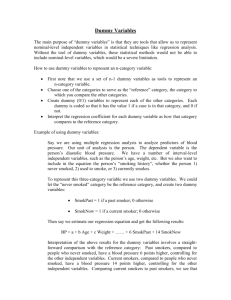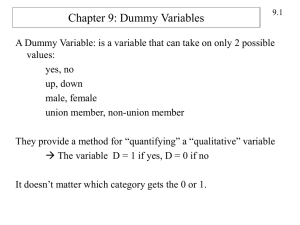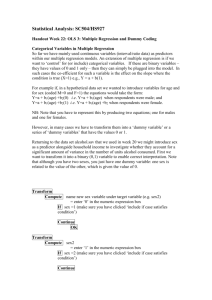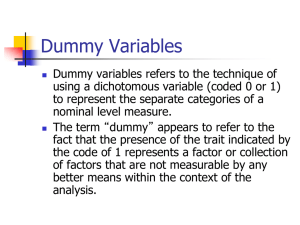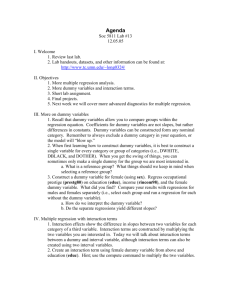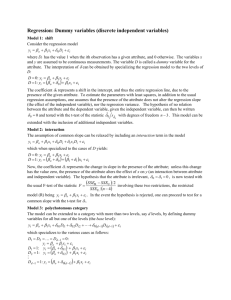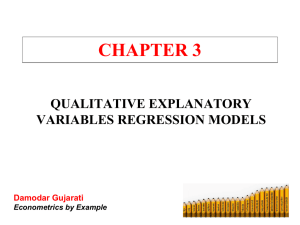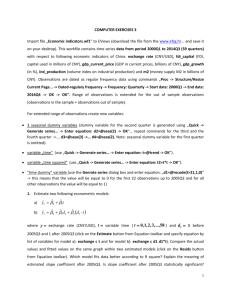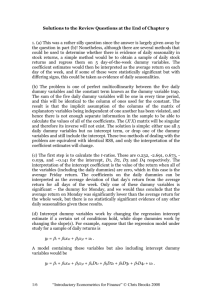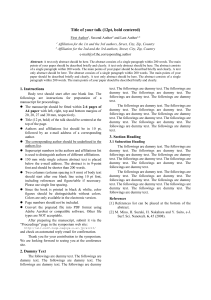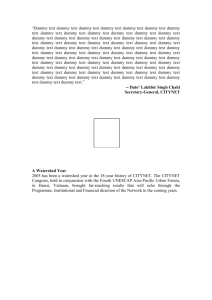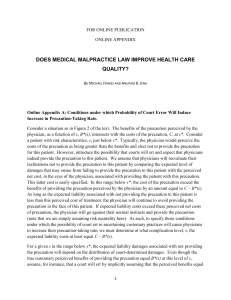Year: The year for the country observations on all the other variables
advertisement
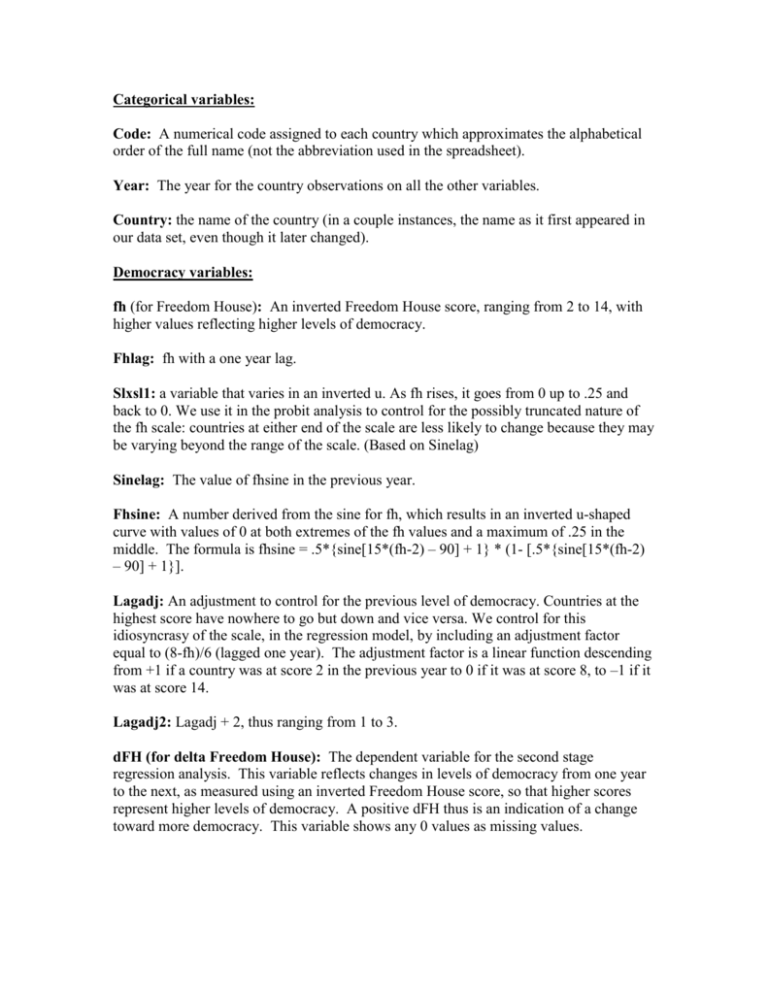
Categorical variables:
Code: A numerical code assigned to each country which approximates the alphabetical
order of the full name (not the abbreviation used in the spreadsheet).
Year: The year for the country observations on all the other variables.
Country: the name of the country (in a couple instances, the name as it first appeared in
our data set, even though it later changed).
Democracy variables:
fh (for Freedom House): An inverted Freedom House score, ranging from 2 to 14, with
higher values reflecting higher levels of democracy.
Fhlag: fh with a one year lag.
Slxsl1: a variable that varies in an inverted u. As fh rises, it goes from 0 up to .25 and
back to 0. We use it in the probit analysis to control for the possibly truncated nature of
the fh scale: countries at either end of the scale are less likely to change because they may
be varying beyond the range of the scale. (Based on Sinelag)
Sinelag: The value of fhsine in the previous year.
Fhsine: A number derived from the sine for fh, which results in an inverted u-shaped
curve with values of 0 at both extremes of the fh values and a maximum of .25 in the
middle. The formula is fhsine = .5*{sine[15*(fh-2) – 90] + 1} * (1- [.5*{sine[15*(fh-2)
– 90] + 1}].
Lagadj: An adjustment to control for the previous level of democracy. Countries at the
highest score have nowhere to go but down and vice versa. We control for this
idiosyncrasy of the scale, in the regression model, by including an adjustment factor
equal to (8-fh)/6 (lagged one year). The adjustment factor is a linear function descending
from +1 if a country was at score 2 in the previous year to 0 if it was at score 8, to –1 if it
was at score 14.
Lagadj2: Lagadj + 2, thus ranging from 1 to 3.
dFH (for delta Freedom House): The dependent variable for the second stage
regression analysis. This variable reflects changes in levels of democracy from one year
to the next, as measured using an inverted Freedom House score, so that higher scores
represent higher levels of democracy. A positive dFH thus is an indication of a change
toward more democracy. This variable shows any 0 values as missing values.
Select: The dependent variable for the first stage probit analysis. A dichotomous
variable in which 1 indicates that the country was “selected” for change in fh in that year
as compared to the previous year. Select is equal to 1 iff dFH is not equal to 0.
Trend: a simple measure of the average change in democracy scores worldwide.
Dltyrcle: Years elapsed since last episode of change
Ddfhaa_1: The mean of the absolute changes in FH for contiguous countries in the
previous year.
Control variables:
Gdpestlo: The base 10 log of an estimate of the per capita gdp for the year, based
primarily on Penn World Tables 5.6’s GDPCH variable, and supplemented for missing
years and countries with values derived from the World Bank’s World Development
Indicators GDP-PPP variable and with UN data.
Grth5: The percentage increase in per capita GDP since the previous year, truncated at 5
percent.
Zg: The predicted probability of a change in FH (predicted by the Probit model).
Lambda: The inverse Mills ratio of the predictions from the Probit model; the correction
for selection bias.
The Expected Diffusion Effects:
We estimated expected diffusion effects using spreadsheets that calculate the average size
of the gap between the target country and each of its neighbors, and then either weighting
them all equally, or using different weighting factors such as GDP, log(10)GDP, relative
population, etc. Each diffusion variable name starts with “dif” or “d” for diffusion and
then contains an abbreviated reference to the weighting factor. The lagged ones (except
for diflag, the unweighted one) end with “_1.”
Diflag: Dif, with a one year lag.
Dif: The simplest diffusion variable, the unweighted average of the differences between
fh for the target country and fh for each of its neighbors.
Difgdp: The gdpest-weighted diffusion variable. The GDP- and land area-weighted
diffusion effects are calculated by weighting the difference between the democracy score
of the target country and that of each of its neighbors by the ratio of the weights, and then
averaging those weighted differences over the whole network. The formula for the land
area and Gdpest- or econsize-weighted expected diffusion effects is:
Di ,t 1
1
k
k
wkt
w
k 1
( Fkt Fit ) , where Di,t+1 is the expected impact of diffusion on
it
target country i at time t + 1, k is the number of countries in the network, wkt is the
weight of the kth country in the network at time t, wit is the weight of country i at time t,
and Fkt and Fit are the democracy scores of countries k and i, respectively, at time t.
Dgdp_1: Difgdp with a one year lag.
USeffect: The difference between the FH of the country and the score of the US, for
countries in the US sphere of influence. Lagged one year.
SOVeffect: The difference between the FH of the country and the score of the Soviet
Union, for countries in the Soviet sphere of influence. Lagged one year.
Blocsov: Dummy variable for membership in the Soviet bloc.
Blocus: Dummy variable for membership in the US bloc.
Dummy variables:
Prezdem: A dummy variable scoring 1 for any country with a presidential system of
government and a dfh score of at least 9, and 0 for all the rest (to identify presidential
democracies).
Prezdemlag: Prezdem lagged one year.
Demlag: 1 if the country had FH>=9 in the previous year; otherwise, 0.
Anglocol: A dummy variable identifying countries with a British colonial history.
Noaf: A dummy for North Africa .
Meast: A dummy for Middle East.
Cam: A dummy for Central America.
Sam: A dummy for South America.
Weur: A dummy for Western Europe.
Fsu: A dummy for countries of the Former Soviet Union.
Paci: A dummy for Pacific nations.
Gulf: A dummy for the Gulf States.
Sasia: A dummy for South Asia.
Ssaf: A dummy for Sub-Saharan Africa.
Seasia: A dummy for Southeast Asian countries.
Nam: A dummy for North America.
Easia: A dummy for East Asia.
Seur: A dummy for Southern Europe.
Soaf: A dummy for Southern Africa.
Eeur: A dummy for Eastern Europe.
Cari: A dummy for Caribbean nations.
Region: This variable identifies the region, as listed above, to which each country
belongs.
Yr73, yr76, etc: The dummy variables for each year are noted as “yrX,” in which X is
the last two digits of the year in question. We include dummies for 1973, ’76, ’77, ’78,
’79, ’80, ’84, ’88, ’89, ’90, ’91, ’92, and ’93.
